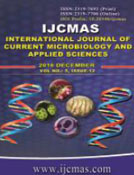


 National Academy of Agricultural Sciences (NAAS)
National Academy of Agricultural Sciences (NAAS)

|
PRINT ISSN : 2319-7692
Online ISSN : 2319-7706 Issues : 12 per year Publisher : Excellent Publishers Email : editorijcmas@gmail.com / submit@ijcmas.com Editor-in-chief: Dr.M.Prakash Index Copernicus ICV 2018: 95.39 NAAS RATING 2020: 5.38 |
Water and ethanol extracts of Punica granatum peels were prepared at the concentration 0.5 and 1.0mg/10ml, silver nanoparticles (4000mg/l) prepared at the same concentrations (0.5 and 1.0mg/10ml). Bacterial samples used in the experiment consisted of two gram-negative bacteria (Escherichia coli and Pseudomonas erogenous) and two gram-positive bacteria (Staphylococcus aurous and Streptococcus pyogenes). All bacterial types were treated either with plant extracts alone or mixed with the same concentrations of silver nanoparticles. Results showed that there was a significant decrease recorded in the mean inhibition zone at 0.5mg/10ml peel water extract (B) (27.5mm), 0.5mg/10ml peel ethanol extract (C) (25.5mm) and 1.0mg/10ml peel ethanol extract (H) (27.7mm) in comparison to the control (A) (32.5mm). According to the type of bacteria the highest mean inhibition zone observed in Staphylococcus aurous bacteria (34.8mm) and the lowest mean obtained in Pseudomonas erogenous bacteria (16.3mm). The interaction between the type of bacteria and treatment types indicated that the highest mean inhibition zone recorded in 1:1 (v/v) of 0.5mg/10ml silver nanoparticles and ethanol peel extract (F), and 1:1 (v/v) of 1.0mg/10ml silver nanoparticles and ethanol peel extract (K) with Staphylococcus aurous bacteria (39.0mm). While there was a significant reduction recognized in the mean inhibition zone with other types of bacterial strains used in the experiment in comparisons to the control (250mg/10ml cefotaxime).
 |
 |
 |
 |
 |